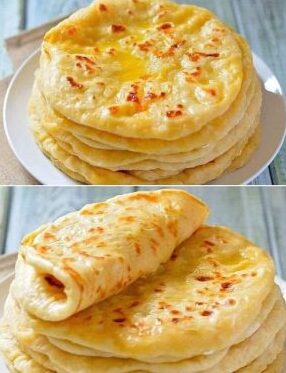Ultimate Guide to Soft, Fluffy Turkish Bread:
Overview of Turkish Bread
Turkish bread is a staple in Turkish cuisine, known for its diverse range of shapes, textures, and flavors. Bazlama, a popular Turkish flatbread, stands out for its thick, fluffy, and tender texture. Similar to pita and naan, bazlama is traditionally cooked on a stovetop or griddle, but baking in the oven yields even fluffier results. This bread is perfect for dipping, wrapping, or serving with meals, and its versatility makes it a favorite in many households. Below, we’ll guide you through creating this authentic Turkish bread at home, using simple ingredients for a foolproof recipe that will make your kitchen smell like a Turkish bakery.
Types of Turkish Bread
Turkey offers a variety of breads, each with its own unique preparation methods and flavors. Here are a few examples:
- Pide: Often referred to as “Turkish pizza,” pide is a boat-shaped flatbread typically topped with cheese, meat, or vegetables.
- Simit: A sesame-coated circular bread, similar to a bagel, often enjoyed at breakfast.
- Lavash: A thin, soft, and unleavened bread traditionally used as a wrap.
- Ekmek: A crusty white bread commonly served with Turkish meals.
- Bazlama: The soft and fluffy flatbread you’ll be making with this recipe. It’s perfect for breakfast, dipping, or as an accompaniment to savory dishes.
Why You’ll Love This Recipe
- Simplicity: You’ll only need basic pantry staples like flour, water, and yeast to create this delicious flatbread.
- Versatility: Bazlama can be enjoyed with a variety of toppings or fillings, or used as a base for sandwiches.
- Authenticity: This is a classic, traditional recipe that captures the essence of Turkish cuisine.
Essential Ingredients for Turkish Bread
Here’s a breakdown of the key ingredients needed to make the perfect bazlama:
- All-Purpose Flour: Provides structure to the dough, helping create a soft yet chewy texture.
- Water: Essential for hydrating the flour and activating the yeast.
- Milk: Adds richness and softness to the dough. It also enhances the flavor and helps the bread achieve a golden-brown color.
- Honey: Acts as food for the yeast, boosting the dough’s rise and giving a subtle sweetness to the bread.
- Active Dry Yeast: Leavens the bread, making it fluffy and light.
- Vegetable Oil: Keeps the bread moist and tender.
- Salt: Enhances the overall flavor and strengthens the gluten structure.
Tools You’ll Need:
- Large Mixing Bowl: To mix and knead the dough.
- Microwave-safe Bowl: To warm liquids and activate the yeast.
- Rolling Pin: For shaping the dough into flat discs.
- Baking Sheet and Parchment Paper: Ensures non-stick baking and easy cleanup.
- Damp Towel or Plastic Wrap: To cover the dough during rising.
Step-by-Step Guide to Making Turkish Bread
- Activate the Yeast: Start by warming the water and milk in a microwave-safe bowl. The liquids should reach around 115°F, warm enough to activate the yeast without killing it. Stir in the honey and yeast and let it sit for about 5 minutes until frothy. The honey acts as food for the yeast, aiding in its activation.
- Incorporate the Wet Ingredients: Once the yeast is bubbly, add the vegetable oil and salt to the mixture. The oil will keep the bread soft and tender.
- Mix and Knead: Slowly add the flour to the liquid mixture, stirring with a wooden spoon until the dough forms. Transfer the dough to a floured surface and knead for 10-15 minutes until smooth and elastic. If using a stand mixer with a dough hook, knead for about 5 minutes.
- Let the Dough Rise: Place the dough back into the bowl, cover with a damp towel, and allow it to rise for an hour in a warm place. This will allow the yeast to ferment and develop the gases needed to puff up the bread.
- Prepare the Oven: Preheat your oven to 450°F with a baking sheet on the middle rack and a small dish of water on the lower rack to create steam. This mimics a steam oven and helps the bread achieve its signature puffiness.
- Shape the Dough: Divide the risen dough into 8-10 equal pieces and roll each piece into a round, flat disc about 1/4 inch thick. Damp hands will help prevent sticking.
- Bake the Bread: Transfer the dough rounds onto the preheated baking sheet and bake for 3 minutes, then flip the bread and bake for another 2 minutes. The bread should puff up and become dry, but not browned.
- Cool and Serve: Let the bread cool slightly before serving. It can be enjoyed plain, with dips, or as a side to soups and stews.
Tips & Tricks for Perfect Turkish Bread
- Use a High-Heat Oven: Preheating the oven to 450°F helps the bread puff up quickly.
- Maintain Steam: Place a dish of water on the lower oven rack to create steam, which is crucial for achieving a fluffy texture.
- Don’t Skip the Resting Time: Allowing the dough to rise for an hour helps it develop the gluten needed for the bread to puff.
- Work with Damp Hands: Bazlama dough can be sticky, but using damp hands and a floured surface will make it easier to handle.
How to Store and Reheat Turkish Bread
- Room Temperature: Keep fresh Turkish bread in an airtight container for up to three days.
- Freezing: Once baked and cooled, freeze the bread for up to 3 months. Reheat in the oven when ready to serve.
- Refreshing Stale Bread: Dampen the bread slightly with water and reheat in the oven to restore its softness.
Serving Ideas
- Breakfast: Serve bazlama with butter and honey or fruit preserves for a delicious morning treat.
- Wraps: Use the bread to wrap grilled meats or vegetables for a satisfying meal.
- Dipping: Pair with hummus, baba ganoush, or your favorite dip for a perfect appetizer.
Flavor Variations
- Herb-Infused: Add finely chopped herbs like parsley or cilantro to the dough for an aromatic twist.
- Spicy: Sprinkle cumin or paprika into the dough for a flavorful kick.
- Cheese-Filled: Stuff the dough with cheese for a gooey, delicious center.


